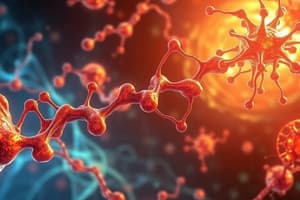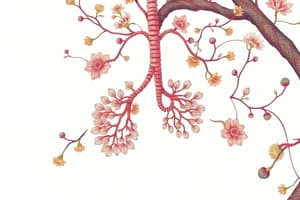Podcast
Questions and Answers
Which of the following correctly states the relationship between anabolic and catabolic pathways?
Which of the following correctly states the relationship between anabolic and catabolic pathways?
- Catabolic pathways produce usable cellular energy by synthesizing more complex organic molecules.
- Anabolic pathways synthesize more complex organic molecules using the energy derived from catabolic pathways. (correct)
- The flow of energy between catabolic and anabolic pathways is reversible.
- Energy derived from catabolic pathways is used to drive the breakdown of organic molecules in anabolic pathways.
Organisms are described as thermodynamically open systems. Which of the following statements is consistent with this description?
Organisms are described as thermodynamically open systems. Which of the following statements is consistent with this description?
- Heat produced by the organism is conserved in the organism and not lost to the environment.
- The metabolism of an organism is isolated from its surroundings.
- Because energy must be conserved, organisms constantly recycle energy and thus need no input of energy.
- Organisms acquire energy from and lose energy to their surroundings. (correct)
Which of the following states the relevance of the first law of thermodynamics to biology?
Which of the following states the relevance of the first law of thermodynamics to biology?
- Living organisms must increase the entropy of their surroundings.
- Energy is destroyed as glucose is broken down during cellular respiration.
- Energy can be freely transformed among different forms as long as the total energy is conserved. (correct)
- Photosynthetic organisms produce energy in sugars from sunlight.
According to the second law of thermodynamics, which of the following is true?
According to the second law of thermodynamics, which of the following is true?
If the entropy of a living organism is decreasing, which of the following is most likely to be occurring simultaneously?
If the entropy of a living organism is decreasing, which of the following is most likely to be occurring simultaneously?
If, during a process, the system becomes more ordered, then __________.
If, during a process, the system becomes more ordered, then __________.
An exergonic (spontaneous) reaction is a chemical reaction that __________.
An exergonic (spontaneous) reaction is a chemical reaction that __________.
The free energy derived from the hydrolysis of ATP can be used to perform many kinds of cellular work. Which of the following is an example of the cellular work involved in the production of electrochemical gradients?
The free energy derived from the hydrolysis of ATP can be used to perform many kinds of cellular work. Which of the following is an example of the cellular work involved in the production of electrochemical gradients?
In general, the hydrolysis of ATP drives cellular work by releasing free __________ that can be coupled to other reactions.
In general, the hydrolysis of ATP drives cellular work by releasing free __________ that can be coupled to other reactions.
How do enzymes lower activation energy?
How do enzymes lower activation energy?
A molecule becomes more oxidized when it __________.
A molecule becomes more oxidized when it __________.
In the overall process of glycolysis and cellular respiration, __________ is oxidized and __________ is reduced.
In the overall process of glycolysis and cellular respiration, __________ is oxidized and __________ is reduced.
Most of the ATP produced in cellular respiration comes from which of the following processes?
Most of the ATP produced in cellular respiration comes from which of the following processes?
The function of cellular respiration is to __________.
The function of cellular respiration is to __________.
A small amount of ATP is made in glycolysis by which of the following processes?
A small amount of ATP is made in glycolysis by which of the following processes?
Where do the reactions of glycolysis occur in a eukaryotic cell?
Where do the reactions of glycolysis occur in a eukaryotic cell?
In an experiment, mice were fed glucose (C6H12O6) containing a small amount of radioactive oxygen. The mice were closely monitored, and after a few minutes, radioactive oxygen atoms showed up in __________.
In an experiment, mice were fed glucose (C6H12O6) containing a small amount of radioactive oxygen. The mice were closely monitored, and after a few minutes, radioactive oxygen atoms showed up in __________.
The energy given up by electrons as they move through the electron transport chain is used in which of the following processes?
The energy given up by electrons as they move through the electron transport chain is used in which of the following processes?
Energy for synthesizing ATP is obtained by ATP synthase directly from which of the following processes?
Energy for synthesizing ATP is obtained by ATP synthase directly from which of the following processes?
During aerobic respiration, molecular oxygen (O2) is used for which of the following purposes?
During aerobic respiration, molecular oxygen (O2) is used for which of the following purposes?
In photosynthesis, plants use carbon from __________ to make sugar and other organic molecules.
In photosynthesis, plants use carbon from __________ to make sugar and other organic molecules.
How does carbon dioxide (CO2) enter the leaf?
How does carbon dioxide (CO2) enter the leaf?
Chlorophyll molecules are in which part of the chloroplast?
Chlorophyll molecules are in which part of the chloroplast?
The source of the oxygen produced by photosynthesis has been identified through experiments using radioactive tracers. The oxygen comes from __________.
The source of the oxygen produced by photosynthesis has been identified through experiments using radioactive tracers. The oxygen comes from __________.
The Calvin cycle occurs in the __________.
The Calvin cycle occurs in the __________.
Molecular oxygen is produced during __________.
Molecular oxygen is produced during __________.
When chloroplast pigments absorb light, __________.
When chloroplast pigments absorb light, __________.
Where do the electrons entering photosystem II come from?
Where do the electrons entering photosystem II come from?
During photosynthesis in chloroplasts, O2 is produced from __________ via a series of reactions associated with __________.
During photosynthesis in chloroplasts, O2 is produced from __________ via a series of reactions associated with __________.
The light reactions of photosynthesis generate high-energy electrons, which end up in __________ through linear electron flow. The light reactions also produce __________ and __________.
The light reactions of photosynthesis generate high-energy electrons, which end up in __________ through linear electron flow. The light reactions also produce __________ and __________.
Flashcards
Anabolic vs. Catabolic Pathways
Anabolic vs. Catabolic Pathways
Anabolic pathways use energy from catabolic pathways to build complex molecules.
Thermodynamically Open Systems
Thermodynamically Open Systems
Organisms exchange energy with their surroundings, both gaining and losing it.
First Law of Thermodynamics
First Law of Thermodynamics
Energy can change forms, but the total amount remains constant.
Second Law of Thermodynamics
Second Law of Thermodynamics
Signup and view all the flashcards
Entropy Decrease in Organisms
Entropy Decrease in Organisms
Signup and view all the flashcards
More Ordered System
More Ordered System
Signup and view all the flashcards
Exergonic Reaction
Exergonic Reaction
Signup and view all the flashcards
Electrochemical Gradients & ATP
Electrochemical Gradients & ATP
Signup and view all the flashcards
ATP Hydrolysis Drives Work
ATP Hydrolysis Drives Work
Signup and view all the flashcards
Enzymes Lower Activation Energy
Enzymes Lower Activation Energy
Signup and view all the flashcards
Oxidation
Oxidation
Signup and view all the flashcards
Glycolysis and Cellular Respiration
Glycolysis and Cellular Respiration
Signup and view all the flashcards
Most ATP Production
Most ATP Production
Signup and view all the flashcards
Function of Cellular Respiration
Function of Cellular Respiration
Signup and view all the flashcards
ATP in Glycolysis
ATP in Glycolysis
Signup and view all the flashcards
Glycolysis Location
Glycolysis Location
Signup and view all the flashcards
Radioactive Oxygen
Radioactive Oxygen
Signup and view all the flashcards
Energy from Electron Transport.
Energy from Electron Transport.
Signup and view all the flashcards
ATP Synthase Energy Source
ATP Synthase Energy Source
Signup and view all the flashcards
Molecular Oxygen Purpose
Molecular Oxygen Purpose
Signup and view all the flashcards
Carbon Source for Photosynthesis
Carbon Source for Photosynthesis
Signup and view all the flashcards
CO₂ Entry into Leaf
CO₂ Entry into Leaf
Signup and view all the flashcards
Chlorophyll Location
Chlorophyll Location
Signup and view all the flashcards
Oxygen Source in Photosynthesis
Oxygen Source in Photosynthesis
Signup and view all the flashcards
Calvin Cycle Location
Calvin Cycle Location
Signup and view all the flashcards
Molecular Oxygen Production
Molecular Oxygen Production
Signup and view all the flashcards
Chloroplast Pigments Absorb Light
Chloroplast Pigments Absorb Light
Signup and view all the flashcards
Photosystem II Electrons
Photosystem II Electrons
Signup and view all the flashcards
Photosynthesis Oxygen Production
Photosynthesis Oxygen Production
Signup and view all the flashcards
Light Reactions Result
Light Reactions Result
Signup and view all the flashcards
Study Notes
- Anabolic pathways use energy from catabolic pathways to synthesize more complex organic molecules
- Organisms are thermodynamically open systems, acquiring and losing energy to their surroundings
- According to the first law of thermodynamics, energy can be transformed but not created or destroyed; total energy remains constant
- The second law of thermodynamics states that energy conversions increase the entropy (disorder) of the universe
- A decrease in entropy in an organism requires energy input
- If a system becomes more ordered during a process, ΔS is negative
- Exergonic reactions release energy when proceeding in the forward direction
- The free energy from ATP hydrolysis performs cellular work like proton movement against a gradient
- ATP hydrolysis drives cellular work by releasing free energy for coupled reactions
- Enzymes lower activation energy by concentrating reactants locally
- A molecule is oxidized when it loses an electron
- In glycolysis and cellular respiration, glucose is oxidized and oxygen is reduced
- Most ATP in cellular respiration is produced by oxidative phosphorylation
- Cellular respiration extracts usable energy from glucose
- Glycolysis produces a small amount of ATP via substrate-level phosphorylation
- Glycolysis occurs in the cytosol of eukaryotic cells
- In experiments with mice fed radioactive oxygen in glucose, the radioactive oxygen ends up in carbon dioxide
- The energy from electrons moving through the electron transport chain pumps H+ across a membrane
- ATP synthase obtains energy for synthesizing ATP from the flow of H+ across the inner mitochondrial membrane
- During aerobic respiration, molecular oxygen accepts electrons at the end of the electron transport chain, forming H2O
- Plants use carbon dioxide to make sugar and other organic molecules during photosynthesis
- Carbon dioxide enters the leaf through the stomata
- Chlorophyll molecules are located in the thylakoid membranes of the chloroplast
- The oxygen produced during photosynthesis comes from water
- The Calvin cycle takes place in the stroma
- Molecular oxygen is produced during linear electron flow of the light reactions
- When chloroplast pigments absorb light, the pigments' electrons become excited
- Electrons entering photosystem II come from water
- During photosynthesis, O2 is produced from H2O via reactions associated with photosystem II
- The light reactions of photosynthesis generate high-energy electrons that end up in NADPH, also producing ATP and oxygen through linear electron flow
Studying That Suits You
Use AI to generate personalized quizzes and flashcards to suit your learning preferences.




